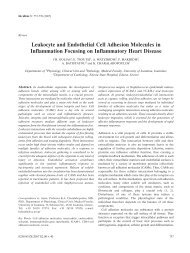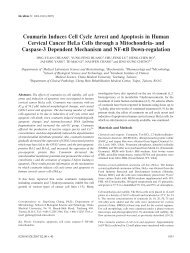RhinoVax® is an Efficient Adjuvant in Oral Immunisation of ... - In Vivo
RhinoVax® is an Efficient Adjuvant in Oral Immunisation of ... - In Vivo
RhinoVax® is an Efficient Adjuvant in Oral Immunisation of ... - In Vivo
You also want an ePaper? Increase the reach of your titles
YUMPU automatically turns print PDFs into web optimized ePapers that Google loves.
adm<strong>in</strong><strong>is</strong>tration <strong>of</strong> <strong>an</strong>tigens (hum<strong>an</strong> IgG) mixed with<br />
adjuv<strong>an</strong>ts (Cholera Tox<strong>in</strong> B-subunit (CTB) or Rh<strong>in</strong>oVax ®<br />
(RV)) to egg-lay<strong>in</strong>g hens c<strong>an</strong> <strong>in</strong>deed <strong>in</strong>duce a systemic<br />
immune response (4). From studies <strong>of</strong> mammals, CTB <strong>is</strong><br />
known to be a potent oral adjuv<strong>an</strong>t (5-7) <strong>an</strong>d <strong>in</strong>tr<strong>an</strong>asal,<br />
<strong>in</strong>tra-<strong>in</strong>test<strong>in</strong>al <strong>an</strong>d oral adm<strong>in</strong><strong>is</strong>tration <strong>of</strong> CTB to chickens<br />
has been reported to potentiate the humoral immune<br />
response (8-10). RV <strong>is</strong> a pegylated mono/di-glyceride, which<br />
has been used successfully as a nasally-adm<strong>in</strong><strong>is</strong>tered<br />
adjuv<strong>an</strong>t <strong>in</strong> cl<strong>in</strong>ical trials <strong>in</strong> <strong>an</strong>imals <strong>an</strong>d hum<strong>an</strong>s result<strong>in</strong>g <strong>in</strong><br />
a systemic IgG response (11, 12). These studies illustrate the<br />
potential <strong>of</strong> oral immun<strong>is</strong>ation as a non-<strong>in</strong>vasive alternative<br />
mode <strong>of</strong> <strong>an</strong>tigen adm<strong>in</strong><strong>is</strong>tration. Comb<strong>in</strong>ed with the harvest<br />
<strong>of</strong> <strong>an</strong>tibodies from chicken eggs, oral immun<strong>is</strong>ation may<br />
completely elim<strong>in</strong>ate d<strong>is</strong>comfort from <strong>an</strong>imals used for<br />
polyclonal <strong>an</strong>tibody production.<br />
The aims <strong>of</strong> the present study were to: i) optim<strong>is</strong>e oral<br />
immun<strong>is</strong>ation protocols focus<strong>in</strong>g on CTB <strong>an</strong>d RV as<br />
adjuv<strong>an</strong>ts, ii) ga<strong>in</strong> <strong>in</strong>sight <strong>in</strong>to the genetic contribution to<br />
the between <strong>an</strong>imal variation <strong>in</strong> immune response, <strong>an</strong>d iii)<br />
test if chicken responsiveness to oral immun<strong>is</strong>ation <strong>is</strong><br />
correlated with responsiveness to traditional (subcut<strong>an</strong>eous)<br />
immun<strong>is</strong>ation.<br />
Materials <strong>an</strong>d Methods<br />
Animals <strong>an</strong>d husb<strong>an</strong>dry. A total <strong>of</strong> 45 (one chicken died<br />
spont<strong>an</strong>eously on day 3 after arrival at the <strong>an</strong>imal house)<br />
approximately 50% <strong>in</strong>-bred (40%-60% homozygosity), one-day-old<br />
White Leghorn female chickens (Gallus domesticus) from Lövsta<br />
Poultry Facility <strong>of</strong> the Swed<strong>is</strong>h Agricultural University, Uppsala,<br />
Sweden, were acclimat<strong>is</strong>ed for two weeks. The chickens orig<strong>in</strong>ated<br />
from 11 hens (A, B, C, D, E, F, G, H, I, J <strong>an</strong>d K), which were<br />
mated with the same cock. Five chickens from each hen (A to E)<br />
were d<strong>is</strong>tributed among the 5 treatment groups so that there was<br />
one s<strong>is</strong>ter <strong>in</strong> each treatment group. Chickens from hens which had<br />
less th<strong>an</strong> 5 <strong>of</strong>fspr<strong>in</strong>g (F to K) were d<strong>is</strong>tributed evenly among the<br />
treatment groups to make a total <strong>of</strong> 9 chickens per treatment group<br />
from 9 different hens (9 blocks). Each chicken was <strong>in</strong>dividually<br />
marked with a numbered alum<strong>in</strong>ium tag clipped to its w<strong>in</strong>g. They<br />
were group-housed on the floor <strong>in</strong> a pen with wood shav<strong>in</strong>gs<br />
(Tapvei, Oy, Kaavi, F<strong>in</strong>l<strong>an</strong>d) as bedd<strong>in</strong>g, <strong>in</strong> a temperature<br />
controlled room with a heat<strong>in</strong>g lamp provid<strong>in</strong>g a horizontal<br />
temperature gradient from 25ÆC to 35ÆC <strong>in</strong> the pen for the first<br />
week after hatch<strong>in</strong>g <strong>an</strong>d 25ÆC for later rear<strong>in</strong>g, with 8 hours dark<br />
<strong>an</strong>d 16 hours artificial light cycle. Food gr<strong>an</strong>ules (batch # 55102,<br />
Odal L<strong>an</strong>tmän, Uppsala, Sweden) free <strong>of</strong> <strong>an</strong>imal prote<strong>in</strong> <strong>an</strong>d tap<br />
water were available ad libitum. The average body weight <strong>of</strong> the<br />
chickens, at 15 days <strong>of</strong> age, was 128.3g (± 4.56g) at the start <strong>of</strong> the<br />
experiment. Body weight was recorded at every immun<strong>is</strong>ation <strong>an</strong>d<br />
blood-sampl<strong>in</strong>g event.<br />
Treatment groups <strong>an</strong>d immun<strong>is</strong>ation scheme: The immun<strong>is</strong>ation<br />
protocol cons<strong>is</strong>ted <strong>of</strong> two Phases, 1 <strong>an</strong>d 2. Phase 1 <strong>in</strong>volved<br />
adm<strong>in</strong><strong>is</strong>tration <strong>of</strong> <strong>an</strong> <strong>an</strong>tigen, Bov<strong>in</strong>e Serum Album<strong>in</strong> (BSA), <strong>in</strong><br />
comb<strong>in</strong>ation with various adjuv<strong>an</strong>t preparations, either Cholera<br />
Tox<strong>in</strong> B- subunit (CTB) <strong>an</strong>d/or Rh<strong>in</strong>oVax ® (RV), given by oral<br />
376<br />
<strong>in</strong> vivo 19: 375-382 (2005)<br />
route, except for the treatment <strong>of</strong> the positive control group which<br />
received Freund’s <strong>In</strong>complete Adjuv<strong>an</strong>t (FIA) by subcut<strong>an</strong>eous<br />
(s.c.) <strong>in</strong>jection.<br />
There were 5 treatment groups with 9 chickens each <strong>in</strong> group 1<br />
(BSA+20% RV), group 2 (BSA+CTB), group 3<br />
(BSA+CTB+RV) <strong>an</strong>d group 5 (100%RV), <strong>an</strong>d 8 chickens <strong>in</strong><br />
group 4 (BSA+FIA). The immunogen mixture was adm<strong>in</strong><strong>is</strong>tered<br />
by gavage to the pharynx at 200 Ìl/chicken. All chickens were<br />
immun<strong>is</strong>ed on days 0, 14 <strong>an</strong>d 28. They were 15 days old when first<br />
immun<strong>is</strong>ed (day 0). The treatment groups were:<br />
Group 1: 2 mg BSA <strong>an</strong>d 20% RV. RV (S<strong>of</strong>tigen ® from Sasol Gmbh,<br />
Witten, Germ<strong>an</strong>y) was added to a concentration <strong>of</strong> 1:5 (v:v) <strong>in</strong> a<br />
BSA (Sigma, Sweden, Cat. No. A-4503) solution (10mg/ml<br />
phosphate-buffered sal<strong>in</strong>e (PBS), pH 8.0).<br />
Group 2: BSA <strong>an</strong>d CTB glutaraldehyde-conjugated. BSA <strong>an</strong>d CTB<br />
(Sigma, Cat. No. C9930) were conjugated (1:1 molar ratio) with<br />
glutaraldehyde. The protocol was based on v<strong>an</strong> der Heijden <strong>an</strong>d<br />
co-workers (13). Briefly, CTB (conta<strong>in</strong><strong>in</strong>g ≤0.5% Cholera Tox<strong>in</strong><br />
A-subunit) <strong>an</strong>d BSA d<strong>is</strong>solved <strong>in</strong> PBS (pH 8.0) were mixed, after<br />
which glutaraldehyde was slowly added to a concentration <strong>of</strong> 15<br />
mM. The mixture was gently stirred for one hour at room<br />
temperature. The reaction was stopped by add<strong>in</strong>g glyc<strong>in</strong>e to reach<br />
a glyc<strong>in</strong>e concentration <strong>of</strong> at least 60 mM. The mixture was<br />
dialysed aga<strong>in</strong>st PBS overnight at room temperature.<br />
Group 3: BSA <strong>an</strong>d CTB <strong>an</strong>d 20% RV glutaraldehyde-conjugated.<br />
BSA <strong>an</strong>d CTB (1:1 molar ratio) <strong>an</strong>d 20% RV were conjugated with<br />
glutaraldehyde as described <strong>in</strong> Group 2.<br />
Group 4: 1 mg BSA with FIA (positive control). A solution <strong>of</strong> 10 mg<br />
BSA d<strong>is</strong>solved <strong>in</strong> 1 ml PBS was emulsified <strong>in</strong> 1 ml <strong>of</strong> FIA (Sigma).<br />
Chickens were immun<strong>is</strong>ed s.c. with 200 Ìl on days 0, 14 <strong>an</strong>d 28.<br />
Group 5: 2 mg BSA <strong>an</strong>d 100% RV. RV was added to a concentration<br />
<strong>of</strong> 1:1 (v:v) <strong>in</strong> a BSA solution (10mg/ml PBS, pH 8.0).<br />
<strong>In</strong> Phase 2, <strong>an</strong>other <strong>an</strong>tigen, hum<strong>an</strong> IgG emulsified with FIA,<br />
was adm<strong>in</strong><strong>is</strong>tered by s.c. <strong>in</strong>jection to all chickens <strong>in</strong> all treatment<br />
groups <strong>of</strong> Phase 1, 14 days after the last oral immun<strong>is</strong>ation, i.e. 42<br />
days after the first immun<strong>is</strong>ation was given (42 dpi). On the last<br />
blood sampl<strong>in</strong>g <strong>in</strong> Phase 1, at 42 dpi, Phase 2 was <strong>in</strong>itiated. Each<br />
chicken <strong>in</strong> every treatment group was immun<strong>is</strong>ed s.c. (4 sites on the<br />
breast with 200Ìl <strong>of</strong> 200Ìg hum<strong>an</strong> IgG emulsified <strong>in</strong> FIA).<br />
<strong>In</strong>jections were given on days 0 <strong>an</strong>d 14.<br />
Collection <strong>of</strong> blood <strong>an</strong>d serum samples. All chickens were bled<br />
(us<strong>in</strong>g a 23-G needle on a 2.5 ml syr<strong>in</strong>ge) from the w<strong>in</strong>g ve<strong>in</strong> (1.0<br />
ml) before every oral or s.c. immun<strong>is</strong>ation. Blood sampl<strong>in</strong>g was<br />
done every fortnight, at the same time when immun<strong>is</strong>ation<br />
treatments were given, i.e. for Phase 1 on days 14, 28 <strong>an</strong>d 42, <strong>an</strong>d<br />
for Phase 2, on days 14 <strong>an</strong>d 28 after the <strong>in</strong>itial s.c. <strong>in</strong>jection (dpsi).<br />
Serum samples were collected from centrifuged clotted blood <strong>an</strong>d<br />
stored at –20ÆC until <strong>an</strong>alys<strong>is</strong>. On the f<strong>in</strong>al day <strong>of</strong> sampl<strong>in</strong>g, the<br />
chickens were exs<strong>an</strong>gu<strong>in</strong>ated by cardiac puncture dur<strong>in</strong>g<br />
<strong>an</strong>aesthesia with 400 Ìl Ketam<strong>in</strong>e (Ketalar, Park-Dav<strong>is</strong>/Warner<br />
Lambert, Sweden) (50mg/ml) <strong>an</strong>d 200 Ìl Xylaz<strong>in</strong>e (Rompun Vet,<br />
Bayer, Sweden) (20mg/ml), <strong>in</strong>jected <strong>in</strong>tramuscularly.<br />
Enzyme-l<strong>in</strong>ked immunosorbent assay (ELISA) qu<strong>an</strong>tification <strong>of</strong><br />
immunospecific chicken <strong>an</strong>ti-BSA IgG, IgM <strong>an</strong>d IgA <strong>an</strong>tibodies.<br />
<strong>In</strong>direct ELISA was used to qu<strong>an</strong>tify the immunospecific <strong>an</strong>ti-BSA<br />
IgG <strong>an</strong>tibody <strong>in</strong> chicken serum. Microtiter plates (Nunc, Roskilde,<br />
Denmark) were coated with 100 Ìg/ml BSA prote<strong>in</strong> st<strong>an</strong>dard<br />
(Sigma Cat. # P-0834) <strong>in</strong> carbonate buffer (pH 9.6, 100 Ìl/well) <strong>an</strong>d<br />
<strong>in</strong>cubated overnight at 4ÆC <strong>in</strong> a mo<strong>is</strong>t chamber. The plates were






